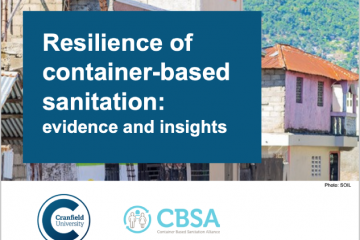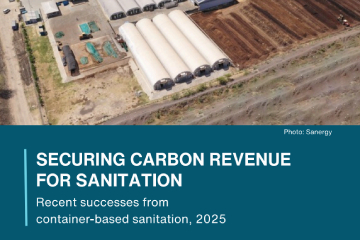Reposted from the IWA blog on iwa-network.org.
The climate crisis demands urgent action across all sectors to reduce emissions and adapt to changing climatic conditions and sanitation is no exception. While there are no quick fixes, emerging research shows that actively managed services such as container-based sanitation benefit both adaptation and mitigation and should have the potential to secure valuable – and so far, elusive – sources of climate finance.
Sanitation is estimated to contribute a whopping 2-6% of global methane and 1-3% of global nitrous oxide emissions. In Kampala, half the city’s emissions are due to sanitation despite the city having many other sources of emissions. Researchers are only recently discovering the significance of sanitation, which has been estimated by the GWI to contribute two-thirds of global WASH emissions, with water contributing the remaining third. Of these, half are estimated to stem from sewers and half from off grid sanitation – the latter largely stemming from anaerobic digestion in pit latrines and septic tanks that are not frequently emptied, and from wastewater treatment plants lacking methane capture.
At the World Water Week session on Mobilizing Innovations: taking action on climate resilient sanitation in last August, convened by partners of the Climate Resilient Sanitation coalition, Barbara Evans of Leeds University presented her recent research on measuring emissions from off grid sanitation. She was clear: there are no magic bullets, BUT but most of the evidence suggests that ‘actively managed WASH’ helps improve resilience and reduce emissions.
How does this work? By frequently collecting and treating waste, and often separating faeces from urine, actively managed services such as container-based sanitation (CBS) reduce anaerobic degradation and related emissions.
In the container-based sanitation (CBS) community, we have long been passionate about seeing sanitation as a service, not just a technology. We’re often asked about our toilet design and hardware, which varies amongst providers – as do their waste treatment processes and human waste-derived products. A key common thread, however, is the service element. To our surprise, we’re now realising that the frequent emptying that the service provides brings added climate benefits – both for adaptation as well as mitigation.
Actively managed services also support adaptation by reducing the risk of untreated waste leaking into the environment during flooding. CBS systems also use little if any water and are thus well suited to areas facing water scarcity.
With the mitigation potential in mind, in 2020 CBSA developed a calculator tool to measure CBS greenhouse gas emissions and found that CBS systems can significantly reduce GHG emissions from sanitation, estimating that the four operators studied collectively mitigated 44,000 tCO2e over a year, representing 60% to 96% of baseline emissions, confirming CBS as a climate-smart solution. Further research in Haiti, found CBS reduced GHG by 126 kg CO2e per person per year. These figures are the equivalent of 112,796 and 323 miles driven by an average petrol-powered car, respectively.
Despite this, the links between sanitation and climate are still lacking. There is minimal inclusion of sanitation in climate policy and financing, including in countries’ Nationally Determined Contributions (NDC) climate pledges and National Adaptation Plans (NAPs). This means that little climate finance, which aims to assist developing countries in adaptation and mitigation practices to counter climate change, reaches water and sanitation projects.
Recognising this, CBSA has been looking into the potential of carbon credits for unlocking a form of climate finance. Our 2022 feasibility study found that, despite several challenges, carbon credits have the potential to provide a viable revenue stream for CBS providers in urban contexts. Modelling CBS scale up projections using existing carbon credit methodologies, the five services examined, collectively earned US$2.4 million in eligible carbon credit revenue over five years for approximately 81,000 toilets and co-treated solid waste.
While this is exciting, accessing carbon credits remains costly and complex and only starts to become viable when operating at a particular scale, i.e., at least a small neighbourhood of 5-10,000 households. Still, given these numbers, the twin benefits of adaptation and mitigation could be an interesting win-win for climate-conscious utilities and for those trying to raise climate finance which is still heavily skewed towards mitigation.
To be clear, while some forms of sanitation may be able to gain revenue from carbon credits, they will not be lucrative enough to close the funding gap left between actual servicing costs and user payments/product sales. This is partly because of the significant registry and consultant fees; partly because the latest emission factors have not yet been officially acknowledged and partly because of many eligibility rules and other carbon credit complexities. CBSA is currently working to address these where possible to make carbon credits more accessible to CBS operators.
The sector still has a long way to go, but the adaptation and mitigation benefits of active management provide an important, and potentially game-changing, opportunity to address climate issues and unlock new sources of funding.


